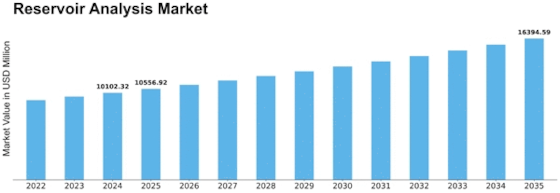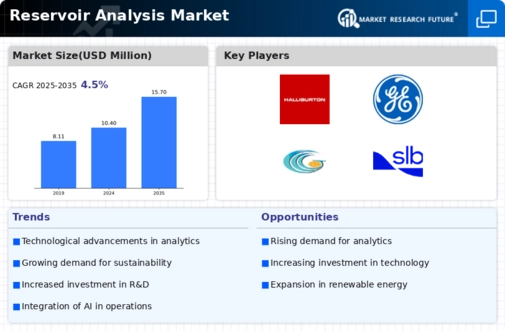Reservoir Analysis Size
Reservoir Analysis Market Growth Projections and Opportunities
Several variables impact the reservoir analysis market's development and dynamics. The rising global energy demand and oil and gas exploration and production drive this market. As the search for additional hydrocarbon sources accelerates, reservoir analysis becomes crucial. The effectiveness of oil and gas operations depends on reservoir analysis, which helps understand subsurface properties, estimate reserves, and optimize production techniques.
Advances in technology shape the reservoir analysis industry. Improved sensor, data analytics, and imaging technologies provide more advanced reservoir analysis tools. Advanced reservoir analysis software and modeling tools help oil and gas firms make better decisions by understanding reservoir dynamics, fluid behavior, and production potential.
The reservoir analysis business is heavily influenced by government rules and environmental concerns. Responsible oil and gas exploration and production are required by strict rules and environmental norms. Analyzing reservoir features and designing solutions that promote safety, efficiency, and environmental sustainability reduces environmental effect. Following rules pushes the deployment of modern reservoir analysis methods and technology.
Economic conditions, oil prices, and industry developments influence market dynamics. Oil price fluctuations affect exploration and production, affecting reservoir analysis demand. Investment in reservoir analysis technology and solutions depends on the economy. Specialized reservoir analysis methodologies are needed because to industry changes including unconventional resources and improved oil recovery. Competition shapes the reservoir analysis market. Service providers and technology developers compete fiercely, spurring innovation and high-performance reservoir analysis tools. Companies provide enhanced features, precision, and reservoir compatibility to distinguish their goods. This competitive climate gives oil and gas companies alternatives and advances reservoir analysis technologies.
The reservoir analysis market is also affected by geopolitics and energy demand. Geopolitical factors including regional tensions and energy policy changes might affect oil and gas exploration and reservoir analysis demand. As the globe moves toward cleaner energy, the oil and gas business confronts new problems and possibilities that affect reservoir analysis research and development.
Environmental concerns and sustainability objectives influence market patterns. Sustainable reservoir analysis solutions are in demand as responsible resource management becomes more important. Reservoir analysis can optimize output and reduce environmental effect, enabling the industry's responsible and efficient operations.
Market dynamics are also affected by oil and gas consumer preferences and awareness. Oil and gas firms want reservoir analysis systems with accurate forecasts, real-time monitoring, and cost-effective reservoir management. Manufacturers and service providers build reservoir analysis technologies that meet industry demands and preferences, enabling flexibility to varied exploration and production situations.
In conclusion, global energy demand, technological advances, government regulations, economic conditions, industry trends, competitive dynamics, geopolitical factors, environmental considerations, and consumer preferences affect the reservoir analysis market. Reservoir analysis players must navigate this complicated terrain to adapt and succeed in a developing market that responds to hydrocarbon exploration and production problems and possibilities.


















Leave a Comment